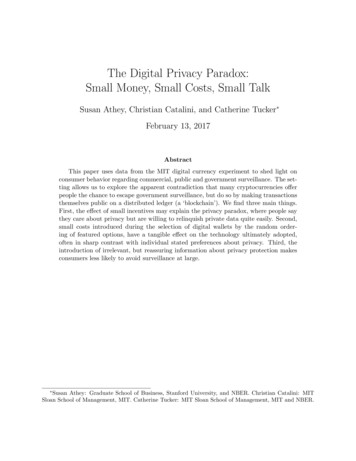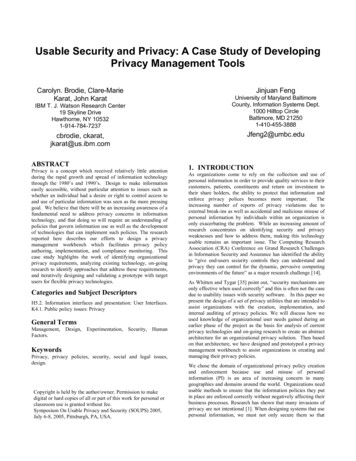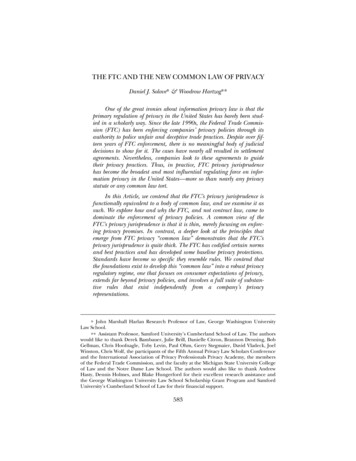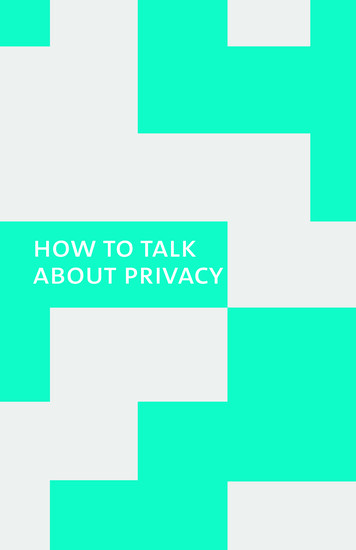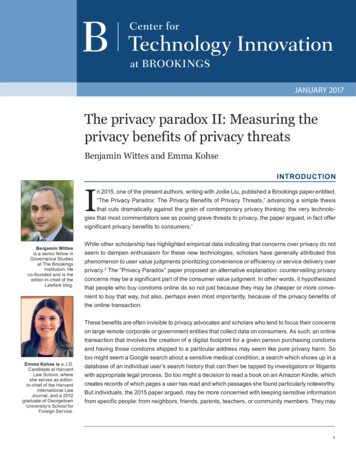
Transcription
JANUARY 2017The privacy paradox II: Measuring theprivacy benefits of privacy threatsBenjamin Wittes and Emma KohseIINTRODUCTIONn 2015, one of the present authors, writing with Jodie Liu, published a Brookings paper entitled,“The Privacy Paradox: The Privacy Benefits of Privacy Threats,” advancing a simple thesisthat cuts dramatically against the grain of contemporary privacy thinking: the very technologies that most commentators see as posing grave threats to privacy, the paper argued, in fact offersignificant privacy benefits to consumers.1Benjamin Wittesis a senior fellow inGovernance Studiesat The BrookingsInstitution. Heco-founded and is theeditor-in-chief of theLawfare blog.Emma Kohse is a J.D.Candidate at HarvardLaw School, whereshe serves as editorin-chief of the HarvardInternational LawJournal, and a 2012graduate of GeorgetownUniversity’s School forForeign Service.While other scholarship has highlighted empirical data indicating that concerns over privacy do notseem to dampen enthusiasm for these new technologies, scholars have generally attributed thisphenomenon to user value judgments prioritizing convenience or efficiency or service delivery overprivacy.2 The “Privacy Paradox” paper proposed an alternative explanation: countervailing privacyconcerns may be a significant part of the consumer value judgment. In other words, it hypothesizedthat people who buy condoms online do so not just because they may be cheaper or more convenient to buy that way, but also, perhaps even most importantly, because of the privacy benefits ofthe online transaction.These benefits are often invisible to privacy advocates and scholars who tend to focus their concernson large remote corporate or government entities that collect data on consumers. As such, an onlinetransaction that involves the creation of a digital footprint for a given person purchasing condomsand having those condoms shipped to a particular address may seem like pure privacy harm. Sotoo might seem a Google search about a sensitive medical condition, a search which shows up in adatabase of an individual user’s search history that can then be tapped by investigators or litigantswith appropriate legal process. So too might a decision to read a book on an Amazon Kindle, whichcreates records of which pages a user has read and which passages she found particularly noteworthy.But individuals, the 2015 paper argued, may be more concerned with keeping sensitive informationfrom specific people: from neighbors, friends, parents, teachers, or community members. They may1
even, somewhat irrationally, be more concerned about the woman behind the counter at CVS, with whom the purchaser actually has to interact in order to purchase condoms in those cash transactions that privacy advocates regardas more protective of privacy than online purchasing. Looking that person in the eye is hard for lots of people, afterall. So such individuals, the paper hypothesized, might be willing to trade a certain degree of privacy from remoteentities like corporations or governments in exchange for greater privacy from the people immediately around themfrom whom they have secrets to keep.[Results] indicate that thereis a quantifiable difference inconsumer preferences that cannotbe explained by factors likeconvenience and that likely reflect aprivacy preference—at least someof the time—for doing business withremote entities that collect data,rather than immediately-presentpeople who might judge us.The initial paper laid out this idea on an intuitive leveland supported it with anecdotes, some initial data, somecircumstantial evidence, and a certain degree of personalexperience. In this paper, however, we seek to sharpenthe picture by testing the theory empirically using GoogleSurveys, an online tool that allows users to create andadminister online surveys to a representative or targetedgroup of respondents.3For a variety of different behaviors with respect to onlineshopping, self-checkout purchases, and e-reader use,we asked pairs of questions about different items, one ofwhich was likely to trigger privacy concerns (condoms,for example), and the other significantly less so (dental floss, for example). Any efficiency or convenience benefitswould presumably occur equally with both types of products, but the privacy effects are likely to be greater withproducts of a sensitive nature.In this paper, we report the results for five such pairs: First, we tested the idea that more readers of Fifty Shades of Grey would prefer to do so on an e-readerthan would readers of a substantially less titillating novel, The Hunger Games. Despite the privacy risksassociated with online purchases generally and e-readers specifically, significantly more people who readFifty Shades reported doing so on an e-reader than among those who read The Hunger Games. Second, we asked respondents about their preferred shopping habits. Very few survey respondents preferred to buy general household items online, but almost double that number preferred to buy products ofa sensitive personal nature online. Third, many more women who bought or considered buying a “personal massager” preferred to do soonline than did women who were considering purchasing an electric fan. Finally, we tested the hypotheses that young men and women would rather use self-checkout to buyproducts like condoms and tampons for reasons beyond convenience and efficiency. The effect herewas notably weaker. Many consumers reported having no preference, though more respondents in bothgroups reported a preference for a human cashier when buying dental floss than when buying productsthey might consider embarrassing.These results, which we lay out in detail in this paper, strongly support the thesis that consumers may have activeprivacy interests in dealing with the very remote, data-collecting companies toward which our privacy fears areThe privacy paradox II: Measuring the privacy benefits of privacy threats 2
generally directed. They indicate that there is a quantifiable difference in consumer preferences that cannot beexplained by factors like convenience and that likely reflect a privacy preference—at least some of the time—fordoing business with remote entities that collect data, rather than immediately-present people who might judge us.Without taking this difference into account, the picture of the lived experience of privacy for hundreds of millions ofreal people, as opposed to the hypothesized privacy priorities of self-appointed privacy watchdogs and scholars,will necessarily remain incomplete. So too will our understanding of the privacy risks and benefits of doing businesswith large entities like Facebook, Google, and Amazon, which we tend to discuss in the language of privacy threatsbut which also are providing privacy benefits to consumers every day.This paper proceeds in five parts. In the first section, we give a brief overview of the 2015 paper, its thesis, thehypotheses proposed that at the time lacked more than anecdotal support, and the academic reaction to it. In thenext part, we offer an overview of Google Surveys, the tool that we used to gather quantitative data to test some ofthese hypotheses. We then describe the design of the study and our methods for developing and refining surveyquestions. As we shall explain, there are some significant problems with polling people about their privacy preferences directly, and Google Surveys has some significant limitations. As a consequence, we self-consciously didnot ask about privacy preferences or attitudes but only about behaviors, and we did so without telling the user thatwe were trying to gauge attitudes about privacy. We also had to word certain questions in a suboptimal fashion toget around the somewhat prudish rules associated with Google Surveys. In the next section, we detail the resultsof the Google Surveys. In the paper’s final part, we offer some conclusions and recommendations for further areaof research.THE “PRIVACY PARADOX” THESIS AND THE RESPONSE TO ITThe core proposition advanced in “The Privacy Paradox” was that “the American and international debates overprivacy keep score very badly and in a fashion gravely biased towards overstating the negative privacy impacts ofnew technologies relative to their privacy benefits.”4 That is, many of the very technologies that privacy advocatesfind so concerning have both privacy-threatening and privacy-enhancing effects. Our debate, however, intellectuallystacks the deck by largely ignoring or dismissing the privacy benefits of new technologies while agonizing endlesslyover their privacy costs. While not denying or minimizing any of the hypothesized costs, “The Privacy Paradox”attempted to fill a gap in the research by focusing on the privacy boons that new technologies create for consumers.It further argued that while the privacy community tends to ignorethese benefits, consumer behavior indicates that individualstake them very seriously when making decisions about howto read, where to shop, and where to look for information.5Weighing privacy against privacy in this way, many individualswill choose to give sensitive data to remote entities in exchangefor greater privacy from those around them.While not denying or minimizingany of the hypothesized costs,“The Privacy Paradox” attemptedto fill a gap in the research byfocusing on the privacy boonsthat new technologies create forconsumers.Some preliminary data and a bunch of anecdotes supportedthis thesis in various settings. The paper looked at the wayGoogle automatically completes user searches for sensitivesubjects, for example, by way of showing that people routinely use Google searches to garner information on sensitive medical and personal conditions.6 It looked at onlineThe privacy paradox II: Measuring the privacy benefits of privacy threats 3
shopping, noting the prevalence of online retailers devoted to sensitive personal products like condoms.7 It notedpreliminary data suggesting that people were more comfortable checking out library books of a sensitive natureusing self-checkout machines8 and some anecdotal suggestions that many people prefer buying condoms usingself-checkout machines as well.9 It noted press reports about the relative popularity of the book Fifty Shades ofGrey on e-readers, as opposed to in physical copies.10 And it looked at data regarding pornography consumptionto show that people are willing to give all sorts of data about themselves to remote, online pornography merchantsin exchange for the ability to consume pornography privately with respect to the people around them;11 the highestrates of consumption of gay pornography online in the United States turn out to be in the Deep South.12But the original “Privacy Paradox” paper had gaps. While it offered the thought experiment of whether condom saleswould rise in CVS stores that install automatic self-checkout machines, major retailers were unwilling to releasedata on the effects of self-checkout on purchasing behavior. So the hypothesis, while intuitively sensible, was hardto measure.Perhaps because it cuts so deeply against conventional thinking about privacy and Big Data technologies, andperhaps because it offered a more theoretical than empirical approach, the “Privacy Paradox” thesis entered thedebate with more of a thud than a bang. New academic research on privacy since its publication has largely notengaged the thesis. But there are a few exceptions. In an articlepublished in the University of Chicago Law Review, Columbia lawConsumer behavior indicatesprofessor David Pozen discusses what he terms “privacy-privacytradeoffs,” including “directional tradeoffs” in which a privacythat individuals take [privacythreat is “redirected so that it comes from one source rather thanbenefits] very seriously whenanother.”13 As an example of such redirection, Pozen describesmaking decisions about howthe privacy benefits of a Kindle e-reader in protecting a readerfrom his fellow subway passengers’ prying eyes, in exchangeto read, where to shop, andfor the increased privacy threat of Amazon’s close tracking ofwhere to look for information.reading habits14 —an example that also features in the original“Privacy Paradox” paper. As does that paper, Pozen’s notes thatthough “[p]rivacy is constantly being juxtaposed with competing goods and interests, balanced against disparateneeds and demands,” the fact that “privacy also clashes with itself” warrants more attention than it gets.15 Pozen,however, urges more focus on how “interventions that strengthen privacy on one margin can end up weakening iton another.”16 This characterization is somewhat the inverse of the focus of the original paper, but it amounts to thesame thing: technologies, like policies, often give privacy with one hand and take it away with the other.In her paper on personal data collection by private companies, Rebecca Lipman also addresses the thesis, acknowledging that “it is definitely a privacy gain to keep your medical concerns or pornography preferences away from peopleyou know, even if the tradeoff is sharing that information with Google.”17 But Lipman uses a kind of nomenclaturetrick to minimize these privacy benefits. Americans are concerned not just about keeping their sensitive informationaway from others, she argues, but also about the tracking or recording of even non-sensitive behaviors or information.18 So privacy, for Lipman, is having the capacity to protect all information, not just the sensitive material, fromrecording by companies and the government, while she characterizes protecting sensitive information from familymembers, neighbors, and storekeepers as something else: “secrecy.”The privacy paradox II: Measuring the privacy benefits of privacy threats 4
In her usage, “secrecy” is a relatively narrow and comparatively unimportant subset of “privacy,” and it seems to followthat gains in secrecy are goods of a smaller magnitude than are the goods lost when privacy as Lipman defines iterodes. The advantage of “Google keeping our embarrassing secrets” is thus balanced against the harm of Google’saccess to the larger category that includes both secrets and everyday, non-sensitive information.19 Furthermore, sheargues that while “we are fairly adept at protecting our privacy in the physical world,” we are less able to do so online.And there, she argues, the consequences are “greater” because the information may be personally identified andstored for an indefinite period of time, probably longer than an eavesdropper’s memory.20 But this is really a valuejudgment on Lippman’s part about what’s important, and it’s a value judgment that the “Privacy Paradox” hypothesized that millions of consumers do not share. Indeed, for an individual, the dignitary consequences of revealingsensitive information to a cashier may be more concrete, and may even be greater, than the abstract consequencesof long-term personal data storage by Amazon.The thesis has also sparked some discussion outside of academia. Journalist John Herrman, writing for The Awl,characterizes the “Privacy Paradox” as describing a “worry” that the ledger of “technology’s privacy impacts.doesn’tfairly represent the semi-related privacy boons we enjoy thanks to some of the most powerful companies in theworld.”21 In Herrman’s view, this faultiness is only a problem for these powerful companies, and not for consumers.22The implication, then, is that perhaps any inaccuracy in the weighing of privacy pros and cons that underestimatesthe pros provided by all-powerful companies is not such a bad thing. In fact, he worries that a version (or perversion)of the “Privacy Paradox” thesis might be used by companies as a means of “misdirection” from the privacy concernsof the new technologies they introduce to the market.23Tim Cushing, a writer at the blog TechDirt, sees the threat as located not in the large companies, as does Herrman,but in governmental access to information collected by those companies.24 While he acknowledges the “PrivacyParadox” thesis as “solid,” he argues that the paper “fails to closely examine government surveillance concerns.”While companies offer concrete benefits in exchange for the privacy losses caused by their technologies, the government only offers the intangible benefit of “security.”25Whatever the merits of these criticisms, it is notable that neither argument disputes that technology’s privacy benefitsare being undercounted in the discussion: Herrman is concerned about the potential consequences of more successful scorekeeping, and Cushing is arguing that the privacy harms side of the equation should be larger to takeinto account governmental surveillance.On a discussion board on the website Hacker News, a social news website run by the startup incubator Y Combinator,26a different criticism arose. In response to a summary of the “Privacy Paradox” theory, a commenter made the familiarargument that consumers are not aware that they are being tracked by companies like Google and Amazon, or atleast are not aware of the extent of the tracking.27 If they were, the argument continues, then they would care a lotmore. And consumer choices that elevate privacy from those around them over privacy from remote entities cannotbe evidence of true privacy preferences if they are uninformed choices. But there is a fair amount of empiricalevidence that most Americans are, in fact, aware that they are being tracked online,28 and it is likely that awarenesswill increase with growing internet literacy and prominent news stories concerning online privacy and security.29In this paper, we aim to sharpen the debate with a series of discrete empirical tests of the “Privacy Paradox” thesis.The goal is both to examine whether, in fact, a gap exists between the privacy expectations and preferences ofThe privacy paradox II: Measuring the privacy benefits of privacy threats 5
ordinary consumers and the theorized privacy expectations of scholars and activists and, to the extent that it doesexist, to begin measuring the magnitude of that gap.MEASURING PRIVACY BEHAVIOR WITH GOOGLE SURVEYSTesting the “Privacy Paradox” thesis, however, is difficult. After all, when a person buys Fifty Shades of Gray on ane-reader, rather than in a hardcover edition, Amazon does not know whether she did so for privacy reasons or forreasons of convenience, and it doesn’t know either which privacy reasons might have been salient: Is the readerembarrassed about the interaction with a cashier or is she shy about being seen on the subway with the book—orboth? Or does she not want her housemates, spouse, or parents to know what she is reading?Similarly, if a reader prefers a hardcover book, it’s not obvious whether that reader preference reflects an aestheticor reading-experience preference for physical books when she’s not traveling or whether it reflects a strong aversionto Amazon’s knowing which passages she singles out as especially riveting and which pages she marks.To glean how lots of people are thinking about these issues, one has to draw inferences from mass behavior, andthe companies in question generally do not release dataon the mass behavior of their customers. So we don’t knowThere is a fair amount ofin any kind of granular fashion how the raciness of a bookempirical evidence that mostcorrelates with mass preferences as to whether to read it inphysical or electronic form. We don’t know whether people,Americans are, in fact, awareon average, would rather brave the store clerk and paythat they are being trackedcash for condoms or tampons and have no record linkingonline, and it is likely thatthem to the sale or whether they prefer to use a credit cardand an address and have those products shipped to themawareness will increase withwithout ever looking anyone in the face. Until companiesgrowing internet literacystart releasing data that bear on such questions, we canand prominent news storiesonly look for proxies for these behaviors and preferences.concerning online privacy andsecurity.Surveys represent a complicated proxy for privacy-implicatingbehaviors. After all, if you ask someone whether he caresabout privacy, he’s very likely to say that he does. Thatsame person, however, is also very likely to engage in all sorts of behaviors that may not comport with those theconventional privacy models would expect of someone who cares about his privacy.30 The result is that the manystudies of consumer attitudes toward privacy show a real gap between people’s stated attitudes and their behaviors. For example, researchers who compared participants’ self-reported opinions about privacy with their behaviorduring an online shopping experience found no correlation between greater concern for privacy and likelihood oftaking privacy-protecting actions.31 Participants who reported concerns about protecting their privacy online wereno less willing to reveal “even highly personal information.”32 In another study, researchers found that people tendedto declare that they would refuse to provide certain personal information to marketers, but did, in fact, reveal thatinformation when asked two weeks later.33 What people say about privacy does not seem to match what they do—even with respect to disclosure of specific personal information.The privacy paradox II: Measuring the privacy benefits of privacy threats 6
For this reason, in this study we specifically did not examine consumer attitudes towards privacy. That is, we didnot ask about what people believe. We asked only about how they prefer to behave, and therefore—since we areworking with a proxy—what those preferences say about what they do. The idea was to create as good a proxyas we could using survey instruments for the sort of data that companies refuse to release—data that sheds lighton the question of whether consumer behavior is guided by, as in the traditional privacy model, a tension betweenconvenience and privacy or, in the “Privacy Paradox” model, by competing and distinct privacy interests.Like any survey instrument, Google Surveys (formerly calledGoogle Consumer Surveys) is an imperfect and somewhatcrude proxy for the sort of nuanced aggregations of privacyand service optimization balancing we are trying to measure.Sample sizes are relatively small, and the methodology is stillcontroversial. On the other hand, Google Surveys allows forinexpensive polling on single questions by people and organizations who are not public opinion professionals.We asked only about howthey prefer to behave, andtherefore—since we areworking with a proxy—whatthose preferences say aboutwhat they do.Google Surveys is a public opinion platform that piggybacksoff of the world’s addiction to Google. It works by providing small incentives to users to answer individual questions on either their smartphones or in the course of their web browsing. Some web sites use Google Surveys asa gateway to premium content: answer a question in exchange for access. And Google also has a mobile app thatallows users to answer questions in exchange for credits on Google Play, the company’s entertainment platform.34The idea is to leverage the gigantic sample of people using the internet into a public opinion research tool availableto companies that pay Google for access to it. Surveys are easy to create on a simple and user-friendly interface.And results come in quickly.Studies assessing the accuracy of Google Surveys data have concluded that it is relatively comparable to moretraditional survey techniques. Nate Silver’s post-2012 election evaluation of polling accuracy ranked Google Surveysas the second-most-accurate of 23 polling firms, with less than half the average error of well-respected polls likeQuinnipiac and Gallup.35 More recently, his website has given Google Surveys a “B” in its “pollster rankings”—aranking that is not top grade but certainly respectable.36 It has been used in academic research in a variety of fieldsranging from psychology to computer science.37The Pew Research Center did a comprehensive study in 2012 comparing the results of Google Surveys with thosefrom Pew dual frame (landline and cell phone) telephone surveys, and found that the median difference betweenthe two groups of results was three percentage points, and the mean difference was six percentage points.38 Theresearchers attributed some of the difference to differences in the structure and administration of the questions.Because Google Surveys does not use a true probability sampling method (i.e. random selection of respondents),Pew expressed concern about differences in the composition of the sample, but actually found that the sample“appears to conform closely to the demographic composition of the overall internet population.”39Of course, only approximately 84 percent of American adults use the internet,40 but it seems that the Google Surveyssample is a representative sample of at least this portion of the population. And though heavy internet users areslightly overrepresented in Google Surveys samples, this bias appears to be small.41 Google’s inferred demographicinformation was not very accurate for individual respondents, especially with respect to age, Pew found, but theThe privacy paradox II: Measuring the privacy benefits of privacy threats 7
overall pool is nonetheless representative.42 Interestingly for our purposes, the largest difference between the GoogleSurveys sample and Pew sample of internet users was in the percentage who reported seeking medical informationonline: only 52 percent of the Google Surveys sample, as compared to 71 percent of the Pew respondents—suggesting, at least tentatively, that this is not a universe of people insensitive to privacy concerns relative to others.43Google itself has done substantial research on the accuracy of its methods. In one study, it compared GoogleSurveys-obtained data and data from probability and non-probability based internet surveys to national media andhealth benchmarks.44 Specifically, it compared Google Surveys results and the results of other, more traditionalsurveys, to very accurate data: viewership information from Video on Demand, Digital Video Record, and satellitedish information, and health information from the Center for Disease Control (CDC).45 The study found that GoogleSurveys deviated least from the benchmarks in terms of average absolute error; it also had the smallest absoluteerror and the highest percentage of responses within 3.5 percentage points.46Still, Google noted the limitations of the platform. The internet population tends to be younger, better-educated, andwealthier than the general population at large, for example.47 What’s more, because Google Surveys asks eachrespondent only one or two questions, it can be hard to assess the relationships between responses, which do notalways involve the same survey samples. In addition, some questions might be regarded as suspicious when theyappear to be blocking content on a website, leading to bias in the responses.48To be sure, some reports are more critical, particularly about the unreliability of inferred demographic information,and they suggest that Google Surveys is more properly used as a supplement to probability based surveys.49 Still, arecent report cautiously concluded that the inferred demographics “may be sufficiently sound for post-stratificationweighting and explorations of heterogeneity.”50 The researchers were able to reproduce the results of four canonicalsocial science studies using Google Surveys, and determined that Google Surveys was likely to be a useful toolfor survey experimenters.51STUDY DESIGNThe ambition of this study was to pose pairs of questions derived from the “Privacy Paradox” thesis, and to thusmeasure the response to privacy-sensitive matters against the response to non-sensitive but otherwise similarsubjects. The idea was to isolate the privacy effect in user preferences and behaviors from those effects associatedwith efficiency, cost savings, or service delivery. In attempting this, we thought it important that respondents notknow they were being asked about privacy but merely about how they behave or what they prefer to do—taking allvariables and goods into account.Working with Google Surveys involved significant constraints, some specifically debilitating to aspects of ourproject. For example, there are limits on whom surveys can target; age demographics start at 18, which makesit tricky to, say, poll LGBT teens about their use of Google searches to explore their sexual identities. Moreover,Google Surveys generally limits surveys to two questions per instrument, or one screening question to target aspecific group, followed by one test question. Additionally, questions have a strict 125-character limit, and answerchoices cannot exceed 44 characters.Most troubling for our purposes, Google must approve the content of all questions, and the company is understandably a little prudish about the subjects concerning which it will and will not let you beam out questions to thousandsof smartphone users around the world. The Google Surveys support team explains that they “don’t allow surveysThe privacy paradox II: Measuring the privacy benefits of privacy threats 8
with content that could be considered adult in nature or contain adult material. This includes adult themes, adultactivity, sexually suggestive material or other elements.”52 Further, “[a]ny surveys regarding any types of contraceptives/birth control is [sic] not allowed.”53 These restrictions made questions about pornography consumptionimpossible, and it required the use of euphemisms to refer to some of the products we would have preferred to askabout explicitly. Indeed, most of the “test” questions from our five pairs contained language that was blocked as weoriginally worded them.Fortunately, Google Surveys’ censorship is relatively half-hearted and inconsistent. So our challenge wa
Fifty Shades reported doing so on an e-reader than among those who read The Hunger Games. Second, we asked respondents about their preferred shopping habits. Very few survey respondents pre-




